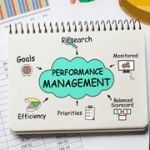Honing your business’s performance management system is one of the quickest ways to success.
 An effective performance management system helps align employees, resources, and systems to meet strategic business goals. Henry Ford said, “Coming together is a beginning; keeping together is progress; working together is success.”
An effective performance management system helps align employees, resources, and systems to meet strategic business goals. Henry Ford said, “Coming together is a beginning; keeping together is progress; working together is success.”
If you think of your company as a sailboat and your employees as the sails, if all the sails are blowing in different directions, you’re not likely to make much forward progress. But if they are working together, the boat will move in the intended direction and get to the destination much quicker.
However, tracking performance is a challenge for many companies. It can be difficult to find the right metrics to record and targets to meet. Plus, there can be issues with employee transparency.
While there are components of performance monitoring that need to be human-based — such as deciding on consequences for missing targets or rewards for meeting them — a lot of the challenges can be overcome with technology.
Performance management tools are making it easier to achieve company-wide alignment. The right technology can allow you to set and track metrics (such as punctuality), standardize performance reviews, and establish goals.
Deloitte’s 2017 Global Human Capital Trends study found that more than 70% of companies who responded were in the process of changing the performance management process in their organizations.
About 83% of more than 10,000 respondents had seen the quality of conversations between employees and managers improve as a result, and 96% said their new processes were simpler and less bureaucratic.
The HR technology available for performance management varies. Certain software providers support a formal process while others have designed their application for an informal performance review process — such as providing journals for managers and employees to document the results of discussions. Other applications allow for anonymous reviews on employee performance.
Questions for determining the type of performance management tool your business needs include:
- Consider what metrics your organization wants to track. This will likely vary by department. What is important for an employee to do to be successful in their role and further the organization?
- How can those metrics be best tracked? For example, are they quantitative (how many times an employee arrived late, number of sales per quarter, etc.) or qualitative (always in a positive mood, has good ideas, etc.)
- How often do you want performance reviews to happen? Daily, weekly, monthly, quarterly, annually?
- What form do you want the performance review process to take? Is a traditional, formal review appropriate for your company, or would a more informal process work best?
- How does your company handle goal setting, big and small? For example, there may be company-wide goals, but there could also be departmental goals, and even project goals and individual goals.
- Would you want a succession planning feature included in your performance management tool?
- Would you want a compensation planning feature included in your tool? This might be helpful if yours is a business where compensation is tied to performance reviews.
- What other software would you want your tool to integrate with? Certain programs work with Outlook, Gmail, Slack, and more.
You don’t have to decide on a performance management system alone. SHEA Global can help you analyze your options, pick the best one, and create an implementation plan. Contact us today to get started. Call (905) 470 6830 or visit SHEAGlobal.com
Performance management starts with bringing the right people into your organization. Discover more about learning how to use social media recruiting for business, with our free eBook, Managing Human Capital in the Social Media World.